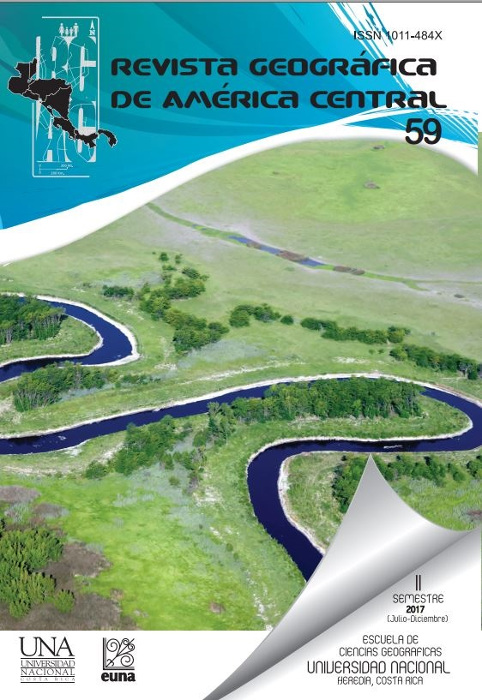Different datum and cartographic projections from Costa Rica: generalities and relations.
DOI:
https://doi.org/10.15359/rgac.3-59.2Keywords:
Ocotepeque datum, CR90 datum, CR98 datum, CR05 datum, projections of Costa RicaAbstract
As of the second half of the 20th century, Costa Rica has been implemented and used a series of map projections. The first official map of the country that worked for decades was based on a projection of Lambert, with two contact parallels and defining the so-called northern and southern areas. This national mapping considered -as a reference surface, Clarke ellipsoid 1866, and the coordinates of the points from triangulation chains as a reference framework. In the early 1990s, a project whose main purpose was to provide the country with a new geodetic network based on satellite positioning via GPS was developed. The adjusted coordinates of the vertexes of this network on the WGS84 ellipsoid constituted the basis of datum CR90, whose data were used in generating CRTM90 projection mapping. At the end of that decade, a research project made by Escuela de Topografía, Catastro y Geodesia (ETCG), brought GPS measurements of several national projects, and made the first adjustment of Costa Rican geodetic network within the International Terrestrial Reference Framework (ITRF) 1994 (Dörries and Roldan, 1999) and (Dörries y Roldán, 2004). This new datum was designated as CR98, and it was related to the CRTM98 projection. In the mid-2000s, the measurement of another national geodetic network within ITRF2000 was performed, which constitutes the basis of the official datum of Costa Rica -known as CR05, and the corresponding official projection mapping CRTM05. The different geodetic networks that have been measured in Costa Rica and their corresponding map projections imply having a large amount of geospatial information, from which it is essential to know its metadata in order to be able to project it to the correct plane or to properly transform it. Although it is true that for many practical applications the working scale does not allow displaying a direct effect on the cartographic product, the proper management of information is essential.
References
Costa Rica. (2007). Decreto ejecutivo 33797-MJ-MOPT. Ministerio de Justica y Gracia. Costa Rica.
Dörries, E. y J. Roldán (1999). Estudio Comparativo del Datum Geodesico de Ocotepeque y el Datum Satelitario del Sistema WGS84. Informe Final Proyecto de Investigación. Escuela de Topografía, Catastro y Geodesía. Universidad Nacional.
Dörries, E. y J. Roldán (2004). El Datum Geodésico de Ocotepeque y el Datum Satelitario del Sistema WGS84. Revista UNICIENCIA, 21(1 y 2), 117-125.
Grosmann, W. (1976). Geodätische Rechnungen und Abbildungen in der Landesvermessung. Verlag Konrad Wittwer, Stuttgart.
Grafarend, E., R. You y R. Syffus (2014) Map Projections Cartographic Information Systemns. Second Edition. Springer-Verlag Berlin Heidelberg. DOI 10.1007/978-3-642-36494-5
Hooijberg, M. (1998). Practical Geodesy Using Computer. Springer-Verlag Berlin, Alemania.
Hooijberg, M. (2008). Geometrical Geodesy Using Information and Computer Technology. Springer-Verlag Berlin. Alemania
Hoffmann-Weelenhof, B., H. Lichtenegger y E. Wasle (2008). GNSS Global Navigation Satellite Systems GPS, GLONASS, Galileo & more. Springer Wein, New York. Estados Unidos.
IAGS. (1950). Proyección Lambert Para Costa Rica. InterAmerican Geodetic Suvey, Estados Unidos de América.
ILIS (1988). Catastro Multifinalitario Programa de Mejoramiento del Catastro Nacional. Reino de los Países Bajos. Dirección General para la Cooperación Internacional (DGIS).
Jekeli, C. (2006). Geometric Reference System in Geodesy. Division of Geodesy and Geospatial Science. School of Earth Sciences. Ohio State University.
Leick, A. (2004). GPS Satellite Surveying. Editorial Wiley. Tercera Edición. Estados Unidos. 464 pp. ISBN: 978-0-471-05930-1
Moya, J. y B. Cedeño (2017). Conceptos básicos en geodesia como insumo para un tratamiento adecuado de la información geoespacial. Revista Geográfica de América Central, 58(1). ISSN 1011-484X. 71-100.
Niemeier, W., J. Roldán, L. Aguilar, H. Pelzer, A. Bagge, W. Augath y W. Seifert (1993). The Project CORBAS - determination of recent crustal movements in Costa Rica. Recent Geodetic and Gravimetric Research in Latin America. IAG Symposium No. 111. Vienna Austria
Torge, W. (2001). Geodesy. 3rd. Edition. Walter de Gruyter-Berlin-New York. 416 pp.
Downloads
Published
How to Cite
Issue
Section
License
Proposed policy for journals offering Open Access
Authors publishing their works in the Journal acknowledge and agree to the following terms:
a) Authors retain the copyrights to their works and guarantee the Journal the right to be the first to publish their works, under the Creative Commons License Attribution-NonCommercial-ShareAlike 4.0 International, CC BY-NC-SA 4.0 International (https://creativecommons.org/licenses/by-nc-sa/4.0/deed.es), which allows others to share works upon complying with the acknowledgment of authorship and mention of the Journal as the original publisher of the work.
b) Authors are permitted to separately establish additional agreements for the non-exclusive distribution of the official edition of the work published in the Journal (for example, authors may desire to place the work in an institutional repository or incorporate it into a book that is to published elsewhere) so long they acknowledgment to recognize the Journal as the original publisher. The aforementioned additional agreements must respect the terms of the non-profit character and sharing philosophy of the original license (CC BY-NC-SA 4.0 International, https://creativecommons.org/licenses/by-nc-sa/4.0/deed.es).
c) Authors are encouraged to archive the post-print or editor/PDF version in Open Access repositories.






 REVGEO is licensed under https://creativecommons.org/licenses/by-nc-sa/4.0/deed.es
REVGEO is licensed under https://creativecommons.org/licenses/by-nc-sa/4.0/deed.es
.svg_4.png)

_(1).png)
_(1)_(1)_(1)_1.png)
(2)(1)(1)(1).png)
